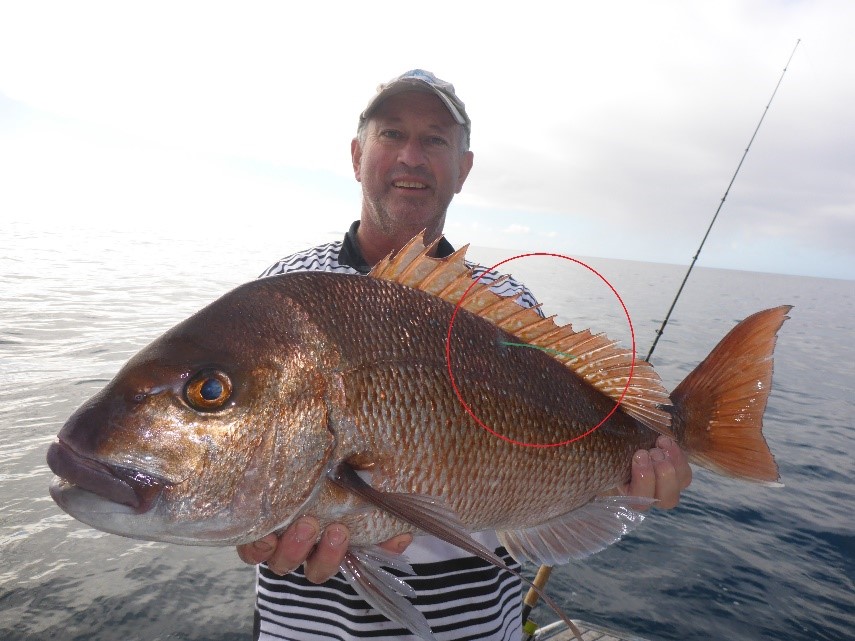Earlier April 2018 Scott & Sue Tindale under took a pilot study to develop an inshore fish tagging program that all New Zealanders could be involved in and would promote ethical angling, environmental education, conservation and research . After reviewing many sucessful overseas programs we took on board the lessons learned from the decades of experiences these programs had encountered. Trialing the best of these ideas in the field gave us the oppotunity to develop a system that suited the New Zealand conditions, the anglers involved and the species we needed to study. The project started with the development of a comprehensive tagging kit. We wanted to include everything in one pack to ensure simplicity for the user. Our first mission on the water involved capturing and releasing many of our popular inshore species. Each fish was accurately measured, fitted with a serial numbered ID tag, photographed and then released. It was important for our results to be productive and that the fish we tagged were handled and tagged in a way that does not harm or alter their natural behaviour. The details collected included: date, species, tag number, release location, longitude, latitude, water depth, fish fork length, sea surface temperature and angler details. Species included in the pilot study were:
Snapper ( Chrysopphrys auratus), Trevally (Pseodocaranax georgianus), Kahawai (Arripis trutta),
Gurnard (Chelidonichthys kumu), Kingfish (Seriola lalandi), Tope (Galeorhinus galeus), and
Tarakihi (Nemadactylus macropterus).
A year later there were over 35 marine fish species in the program. By 2023 there were over 65 species tagged throughout New Zealand waters.


Tagging has long been a simple tool to track seasonal movements preferred habitat & growth of marine species and has been used in over 100 countries worldwide. Up until now NZ recreational anglers have only had the option to tag pelagic species like Marlin and Tuna through the co-op tagging programme setup by the NZ government. This left a huge information gap on the species that reside in our coastal waters year round.
Our first recapture from this pilot study was a snapper caught during a commercial trawl miles off the Taranaki coast. The fish measured a fork length of 38cm.
This fish was originally tagged by Sue Tindale on the 2nd of April 2018 while fishing the Omokoiti flats, Kaipara harbour. It was released at a depth of 2.8m and measured a fork length (tip of nose to v of tail) of 36cm.
In the 41 days at large the snapper travelled a shortest distance of in excess of 165 nautical miles (305km).
50 more tagged fish recaptures were made in the first year since the launch of the inshore tagging program in late 2018.
As with all research projects it is imperative to collect accurate information. We ask that you all keep an eye out for tagged fish while out fishing. If you find one Please record and forward the following capture details;
Date…… tag number….. species…… recapture location…….
latitude and longitude…….. fork length………
and your details……
This can be reported via the details on the tag, Phone or email, or via the fish tag recovery form on our website
We would also like any comments you would like to add and a photo or two if possible for promotional use. Fish Tag Recovery forms can also be download on line at https:/tindaleresearch.org.nz/tagging-program/fish-tag-recovery-form/
As recreational anglers we always have the option of re-releasing fish. Before releasing a tagged fish please record the same details above with a note that the fish was released live and leave the original tag in place.

TMRCT inshore Tagging kit

The running of citizen science programs and assisting in many research projects is a major undertaking. There was a lot of interest from anglers, marine biology students, research institutions and the public following our initial pilot study, Many have since partnered or joined in the tagging project therefore this program was expanded to include all inshore species.
- Tagging kits and additional tags are available to anyone interested in participating in the program. These are sold at cost and can be purchased off our website, Trademe, at events, or by emailing tindaleresearch@xtra.co.nz .
Projects like this would not be possible without the support of a wide range of organisations, sponsors and volunteers so we welcome any additional contributions
Regular updates will be posted on the Tindale Marine Research Charitable Trust Facebook page and on our website newsletter section.
If you would like to know more check out the drop down tabs at the top of this page.
Email us if you would like to organise an event or a club talk on the trusts marine research projects.
How to measure, tag and release a Snapper
How to measure an Eagle Ray. Tagged and released
If you would like to tag and release your own catches you can purchase tags and accessories from this website via the tagging program drop down at the top of this page and click on the order tagging gear page. alternatively you can follow the link
https://tindaleresearch.org.nz/tagging-program/order-tagging-gear/
Join the cause and Donate today
As we are a Charitable Trust, your donations are 100% tax deductable.
A donation receipt will be provided for tax purposes
